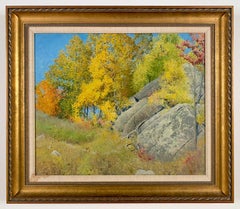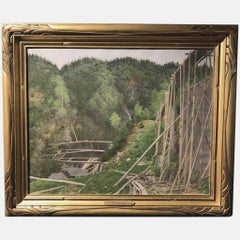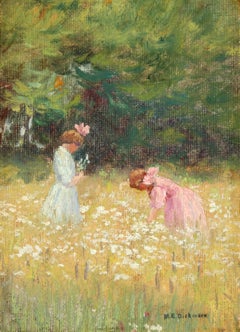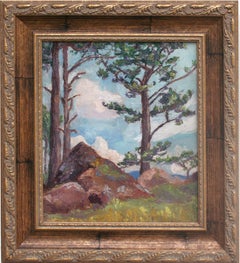Frank Vincent Dumond Art
American, 1865-1951
Born in Rochester, New York in 1865, Frank DuMond left his work as an illustrator at age 23 to study in the rigorous classical atelier tradition of the Academie Julian Paris in 1888. Upon his return to New York in 1892, DuMond embarked on a painting and teaching term at the Art Students League spanning nearly six decades until his death.
A painter of diverse talents, he was an accomplished landscape, portrait and still life painter, muralist, and leader of the Tonalist then Impressionist art colonies of Lyme, Connecticut. In particular, DuMond was noted for his use of landscape green. American Impressionist expert William H. Gerdts wrote of DuMond, "As one might speak of Velazquez's blacks, one must speak of DuMond's greens." Scholars have described him as a deft painter of the American Impressionist landscape and the figure, but he will perhaps be remembered as among the most outstanding educators in American art history. Though an accomplished painter, he is said to have considered himself more of an educator than an artist.
By all accounts, DuMond is described by his students as a man whose art and teaching methods were based on deeply held religious and philosophical beliefs. One student recalls, "There were occasions when DuMond revealed a clear intent to educate us on a deeper level than might casually be associated with painting." His students remember him fondly as "a genial, generous, and perceptive instructor…whose warmth and kindness pervaded everything he did." Under his tutelage, many prominent American artists were brought to recognition, including Georgia O'Keeffe, Norman Rockwell, and John Marin. Still other protégés of DuMond renown became influential teachers, such as Baroque-style painter Frank Mason, whose influence emerged in New York at the Art Students League; and Arthur Maynard and Alban Albert, whose influences emerged at the Ridgewood Art Institute to form another branch of DuMond student legacy.
It was in his early training in Paris that he absorbed the influences of his teacher Gustave Boulanger, Benjamin Constant and Jules-Joseph Lefebvre and the Barbizon and increasing popular Impressionist style. In frequent trips to the French countryside, DuMond was disciplined in painting the naturalistic landscape. Many Barbizon School landscape precepts-such as a sublime vision of the natural world, and an interest in the transient effects of light and shade to depict and dramatize it-have been handed down through generations of painters and continue to pervade art theory today.
Dumond's teaching continues to influence much of our present-day instruction. DuMond students were taught to see the progression of prismatic light flowing from yellow to red to violet on the warm side; and from yellow to green to blue-green to violet on the cool side.
Variations of the palette used by DuMond-consisting of premixed blues, grays, violets and greens in tonal progression from cadmium yellow to red are still used by many instructors at the Ridgewood Art Institute and by artists around the country.(Biography provided by Lincoln Glenn)
to
6
6
5
1
1
1
1
1
Willows, Old Lyme, CT Summer landscape
By Frank Vincent Dumond
Located in Greenwich, CT
A gorgeously colored summer landscape by Important American Impressionist, Frank V Dumond. Fresh in color and elegant in the tonally complimentary French frame with silk liner. Atm...
Category
1910s Impressionist Frank Vincent Dumond Art
Materials
Oil, Board
"The South Wind, " Frank Dumond, Connecticut Impressionism, Old Lyme Landscape
By Frank Vincent Dumond
Located in New York, NY
Frank Vincent DuMond (1865 - 1951)
The South Wind, 1907
Oil on canvas
26 x 36 inches
Signed and dated lower left
Provenance:
Cooley Gallery, Old Lyme, Connecticut
Born in Rochester, New York in 1865, Frank DuMond left his work as an illustrator at age 23 to study in the rigorous classical atelier tradition of the Academie Julian Paris in 1888. Upon his return to New York in 1892, DuMond embarked on a painting and teaching term at the Art Students League spanning nearly six decades until his death.
A painter of diverse talents, he was an accomplished landscape, portrait and still life painter, muralist, and leader of the Tonalist then Impressionist art colonies of Lyme, Connecticut. In particular, DuMond was noted for his use of landscape green. American Impressionist expert William H. Gerdts wrote of DuMond, "As one might speak of Velazquez's blacks, one must speak of DuMond's greens." Scholars have described him as a deft painter of the American Impressionist landscape and the figure, but he will perhaps be remembered as among the most outstanding educators in American art history. Though an accomplished painter, he is said to have considered himself more of an educator than an artist.
By all accounts, DuMond is described by his students as a man whose art and teaching methods were based on deeply held religious and philosophical beliefs. One student recalls, "There were occasions when DuMond revealed a clear intent to educate us on a deeper level than might casually be associated with painting." His students remember him fondly as "a genial, generous, and perceptive instructor…whose warmth and kindness pervaded everything he did." Under his tutelage, many prominent American artists were brought to recognition, including Georgia O'Keeffe, Norman Rockwell, and John Marin. Still other protégés of DuMond renown became influential teachers, such as Baroque-style painter Frank Mason, whose influence emerged in New York at the Art Students League; and Arthur Maynard...
Category
Early 1900s American Impressionist Frank Vincent Dumond Art
Materials
Canvas, Oil
"Train Trestle, " Frank DuMond, Old Lyme Connecticut Impressionism Landscape
By Frank Vincent Dumond
Located in New York, NY
Frank Vincent DuMond (1865 - 1951)
Train Trestle
Oil on canvas
24 x 30 inches
Signed lower left; estate stamped on the reverse
Provenance:
Estate of the...
Category
Early 20th Century American Impressionist Frank Vincent Dumond Art
Materials
Canvas, Oil
Trout Rock- American Impressionist
By Frank Vincent Dumond
Located in Miami, FL
This stunning work features Mr. Dumond's trademark green.
Trout Rock
Signed lower left: F. V. Dumond
Titled on stretcher with artist's estate stamp: Trout Rock
From a Texas Estate.
Frank Vincent Dumond was an artist, illustrator, and painter of the Tonalist school...
Category
1930s American Impressionist Frank Vincent Dumond Art
Materials
Oil
Sunny Hedge
By Frank Vincent Dumond
Located in Sheffield, MA
Frank Vincent Dumond
American, 1865-1931
Sunny Hedge
Oil on canvas
Signed "F.V. DuMond," lower right
24.5 in. by 29 in. W/frame 32.5 by 37 in.
Born in Rochester, New York in 1865, Frank DuMond left his work as an illustrator at age 23 to study in the rigorous classical atelier tradition of the Academie Julian Paris in 1888. Upon his return to New York in 1892, DuMond embarked on a painting and teaching term at the Art Students League spanning nearly six decades until his death.
A painter of diverse talents, he was an accomplished landscape, portrait and still life painter, muralist, and leader of the Tonalist then Impressionist art colonies of Lyme, Connecticut. In particular, DuMond was noted for his use of landscape green. American Impressionist expert William H. Gerdts wrote of DuMond, "As one might speak of Velazquez's blacks, one must speak of DuMond's greens." Scholars have described him as a deft painter of the American Impressionist landscape and the figure, but he will perhaps be remembered as among the most outstanding educators in American art history. Though an accomplished painter, he is said to have considered himself more of an educator than an artist.
By all accounts, DuMond is described by his students as a man whose art and teaching methods were based on deeply held religious and philosophical beliefs. One student recalls, "There were occasions when DuMond revealed a clear intent to educate us on a deeper level than might casually be associated with painting." His students remember him fondly as "a genial, generous, and perceptive instructor…whose warmth and kindness pervaded everything he did." Under his tutelage, many prominent American artists were brought to recognition, including Georgia O'Keeffe, Norman Rockwell, and John Marin. Still other protégés of DuMond renown became influential teachers, such as Baroque-style painter Frank Mason, whose influence emerged in New York at the Art Students League; and Arthur Maynard...
Category
1920s Post-Impressionist Frank Vincent Dumond Art
Materials
Oil
Landscape with Wooden Train Trestle
By Frank Vincent Dumond
Located in Milford, NH
This landscape with a wooden railroad or train trestle was painted by American artist Frank Vincent DuMond (1865-1951). DuMond was a native of Rochester,...
Category
Early 20th Century Realist Frank Vincent Dumond Art
Materials
Canvas, Oil
Related Items
Frances and Ruth Jennings in a Field of Flowers
Located in Concord, MA
MABEL E. DICKINSON POND (1869-1960)
Frances and Ruth Jennings in a Field of Flowers, 1909
Oil on canvas on paperboard
7 x 5 inches
Signed at lower right: M. E. Dickinson
Inscribed v...
Category
Early 1900s American Impressionist Frank Vincent Dumond Art
Materials
Oil
Early 20th Century Pacific Coast Summer Landscape
By Margaret Wherry Ziegler
Located in Soquel, CA
Beautiful early 20th century plein air-style landscape by Margaret Wherry Ziegler (American, 1909-1989), c.1930. Trees, rocks, and meadow grass and flowers bask under a blue sky in this sunny summer landscape scene.
Signed and dated 1930 on verso stretcher bar.
Presented in a vintage wood frame.
Image size: 14.25"H x 12.25"W
Ziegler was born in Cincinnati, Ohio in 1909 At a young age she traveled with her parents to the Philippines, Japan, India, Italy, Greece, and Europe. She studied art at the Cincinnati Art Academy, Minneapolis Art Institute, the University of the Philippines, and the California College of Arts and Crafts. While in Japan she studied Japanese brush painting...
Category
Early 20th Century American Impressionist Frank Vincent Dumond Art
Materials
Canvas, Oil
H 21 in W 19 in D 2 in
1880s Figurative Sackett's Calvary Charge of the 9th New York Volunteers
Located in Soquel, CA
Late 19th century figurative painting of the battle of Trevilians Station and of the wounding of Colonel Sackett June 11, 1864. Oil on canvas in giltwood frame. Signed or notated indistinctly lower right. Image, 20.25"H x 36.25"W.
Military History Prior to 1865
The 9th New York Cavalry contained two companies from Cattaraugus County. It was mustered into the service October 1, 1861 and, until mustered out in July, 1865, lost 619 officers and men out of a total enlistment of a little less than two thousand. It participated in many battles and skirmishes and lost its colonel, William Sackett, who was killed at Trevilian Station, Virginia, on June 11, 1864.
From the Albany Evening Journal, July 20, 1864:
Another name is added to the list of hero martyrs who have fallen in the service of their country. Col. WILLIAM SACKETT, of the Ninth New-York Cavalry, (son of Hon. W.A. SACKETT,) was mortally wounded in the engagement, under Gen. SHERIDAN, at Pavillion Station, Va., and died on the 14th ult. As he was left behind, the sad intelligence of his decease has but just been received.
Col. SACKETT had seen much service. He entered the army on the 22d of April, 1861, was appointed Major of the Ninth New-York Cavalry in October of the same year, was promoted to Lieutenant-Colonelcy in August, 1862, and in March, 1863, became commander of the regiment. He was with Gen. MCCLEELAN in the Peninsula campaign, was in all the cavalry actions of the campaign which followed, was with the army in its advance after the battle of Antietam, and in almost constant conflict with the enemy until after the battle of Fredericksburgh. He participated in most of the cavalry engagements under Gen. HOOKER's command, was in all the principal cavalry actions during LEE's invasion of Maryland and Pennsylvania in 1863, and was among the first engaged in the terrible conflict at Gettysburgh, where he performed distinguished service in holding a rebel brigade in check a long time while our forces were getting into position on the crest of the hill. He was active in the cavalry skirmishes which ensued in the latter part of the Summer.
During the present campaign he was with Gen. SHERIDAN in all his brilliant expeditions up to the time when he fell. He died while leading a charge against the enemies of his country -- died, as he wished to die, doing his whole duty. He was brave, he was generous, he was unflinchingly faithful to the cause of the Union. He loved the old flag with a love that was stronger than life, and esteemed it glorious to fall in its defense. He was born in Seneca Falls, and was 25 years of age.
When the great civil war broke out [William Sackett] was practicing law at Albany, N. Y., having a short time previous been admitted to the bar. In December, 1861, he was commissioned Major of the 9th Regiment of New York Cavalry, and taking the field served with credit in several engagements in which that command participated. On June 27, 1862, his immediate superior, Lieutenant- Colonel Hyde, resigned and three days later Major Sackett was commissioned to fill the vacancy. On the 30th of the following May he was advanced to the Colonelcy of his regiment, with rank from March 15, 1863.
It is stated in "Battles and Leaders of the Civil War" that the cavalry pickets commanded by Colonel Sackett fired the first shot at the battle of Gettysburg. He subsequently led his command, in a gallant manner, in numerous engagements, including the battle of Trevilians Station, fought June 10, 1864. There he received a mortal wound and died inside of the enemy's lines some three days later. The report that he had been severely wounded and was in the hands of the enemy soon reached his wife, who immediately determined to make an effort to reach and care for him, not knowing that he was already dead when the report reached her. The following correspondence, copied from Official Records published by the War Department, tells in most emphatic terms of her devotion.
City Point, Va., July 7, 1864.
General R. E. Lee, Commanding Confederate Army,
Mrs. Sackett, the wife of Colonel William Sackett, who was wounded on the 11th of June, near Trevilians Station, Va., is here in deep distress and feeling great anxiety to learn the fate of her husband. Colonel Sackett was left at a house some two miles and a half from the station, in charge of...
Category
1880s American Impressionist Frank Vincent Dumond Art
Materials
Oil, Linen
H 25.75 in W 41.75 in D 1.25 in
California Chaparral, Botanical Plant Landscape
By Jesse Don Rasberry
Located in Soquel, CA
Beautiful botanical oil painting of California plant life, featuring chaparral landscape with Creosote bush in bloom by Jesse Don Rasberry (American, b. 1940). Signed by the artist i...
Category
1990s American Impressionist Frank Vincent Dumond Art
Materials
Canvas, Oil
H 14.5 in W 18.5 in D 0.75 in
Mid Century Country Lane Figurative Landscape with Autumn Trees
Located in Soquel, CA
Quaint pastoral landscape of a figure and dog walking down a country lane amongst tall autumn trees with beautiful fall foliage by Cal Donna Zell (American, 20th Century). Signed "Ca...
Category
1960s American Impressionist Frank Vincent Dumond Art
Materials
Board, Oil
H 21.75 in W 28 in D 0.13 in
"Florida Landscape"
Located in Southampton, NY
Circa 1875
Unsigned
Original gold leaf frame with wear Overall size with frame 7 x 9.25 in.
Category
1870s Impressionist Frank Vincent Dumond Art
Materials
Oil, Board
"Tavern Snow, West Village" Impressionistic Oil Painting in New York City 1920s
By Cindy Shaoul
Located in New York, NY
"With shades of Pierre Bonnard’s Parisian street vistas and Edward Hopper’s New York shopfronts, American impressionist Cindy Shaoul’s oil paintings depict the much-loved locales and...
Category
2010s American Impressionist Frank Vincent Dumond Art
Materials
Oil, Canvas
Early 20th Century Redwood Forest Sunset Reflections Landscape
By William Lemos
Located in Soquel, CA
Beautiful early 20th century landscape of sunset over redwood forest stream by William Lemos (American, 1861-1942). Unsigned. Presented in the original ...
Category
1930s American Impressionist Frank Vincent Dumond Art
Materials
Canvas, Oil
H 25.75 in W 14 in D 3 in
Sherman Rocks - Mid Century Utah Desert Rock Formation Landscape, 1940s
Located in Soquel, CA
Wonderful mid-century desert landscape of Sherman Rocks, Utah, featuring an impressive rock formation in an arid setting under blue skies by John Wilcox (A...
Category
1940s American Impressionist Frank Vincent Dumond Art
Materials
Oil, Canvas
H 32.5 in W 38.5 in D 3.5 in
Monterey Cypress Tree Sunset - Carmel California Coastal Landscape
By Jesse Don Rasberry
Located in Soquel, CA
Vibrant coastal landscape of a gently leaning Monterey Cypress tree in Carmel as the sunset lights up the ocean and sky by Jesse Don Rasberry (American, b. 1940). Signed by the artis...
Category
1990s American Impressionist Frank Vincent Dumond Art
Materials
Oil, Cardboard, Canvas
Sunlit Path
By JD Henderson
Located in Hillsborough, NC
Impressionist/Post impressionist style painting 'Sunlit Path' by Scottish contemporary artist JD Henderson, gives us this country garden scene dated 1999 (verso), signed by the artis...
Category
1990s Post-Impressionist Frank Vincent Dumond Art
Materials
Canvas, Oil
Purple and Red Mesa Landscape
By Jesse Don Rasberry
Located in Soquel, CA
Bold oil painting of a sunset over mesas in the American Southwest by Jesse Don Rasberry (American, b. 1940). Signed by the artist in the lower right corner. Presented in a deep red ...
Category
1990s American Impressionist Frank Vincent Dumond Art
Materials
Canvas, Oil, Illustration Board
Frank Vincent Dumond art for sale on 1stDibs.
Find a wide variety of authentic Frank Vincent Dumond art available for sale on 1stDibs. You can also browse by medium to find art by Frank Vincent Dumond in oil paint, paint, canvas and more. Much of the original work by this artist or collective was created during the 20th century and is mostly associated with the Impressionist style. Not every interior allows for large Frank Vincent Dumond art, so small editions measuring 22 inches across are available. Customers who are interested in this artist might also find the work of Gifford Beal, William Lester Stevens, and Victor Coleman Anderson. Frank Vincent Dumond art prices can differ depending upon medium, time period and other attributes. On 1stDibs, the price for these items starts at $7,500 and tops out at $25,000, while the average work can sell for $10,700.




